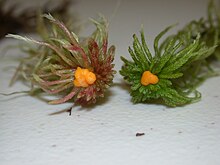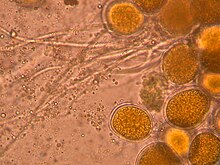Endogone
| Endogone | |
|---|---|

| |
Fruiting body of Endogone pisiformis
| |

| |
| Double-walled zygospores of E. pisiformis | |
| Scientific classification | |
| Kingdom: | Fungi |
| Division: | |
| Subdivision: | |
| Order: | |
| Family: | Endogonaceae |
| Genus: | Endogone Link (1809)
|
| Type species | |
| Endogone pisiformis Link (1809)
| |
| Species | |
|
~25, see text | |
Endogone is a
Species of Endogone form underground structures called
Taxonomy
Endogone was first circumscribed by
The generic name is derived from the Greek words endo (inside) and gone (reproductive organs).[8]
Description
Endogone species are sporocarpic—they form a fruit body termed a
Ecology
Depending on the species, sporocarps have been noted to have the odor of onions, burnt sugar, or fish.[9] Endogone grows in soil, on rotting wood, sphagnum or other plant material either as saprobes or ectomycorrhizal associates.[10] Endogone is especially important in the ecology of nutrient-poor soils. For example, Endogone fungi are known to grow in sand dunes, a nutrient-deficient substrate. Dune plants are dependent upon the fungus for growth and ecological success: the mycelium of the fungus helps aggregate and stabilize the sand in a network of hyphae, giving it cohesion and helping early succession plants establish roots. It also traps and binds fragments of organic material such as decaying roots and rhizomes.[11]
Various species of rodents and shrews include Endogone fungi in their diets, including the
Species
- E. acrogena Gerd., Trappe & Hosford 1974
- E. aggregata P.A.Tandy 1975 – Australia[18]
- E. alba (Petch) Gerd. & Trappe 1974
- E. arenaria Thaxt. 1922[5]
- E. aurantiaca Blaszk. 1997[19]
- E. crassa P.A.Tandy 1975 – Australia[18]
- E. flammicorona Trappe & Gerd. 1972
- E. incrassata Thaxt. 1922[5]
- E. irregularis Szem. 1965
- E. kaiseriana Henn. 1908
- E. lactiflua Berk. 1846
- E. lanata Harkn. 1899
- E. maritima Blaszk., Tadych & Madej 1998[20]
- E. minutissima Beeli 1924 – Europe[21]
- E. oregonensis Gerd. & Trappe 1974
- E. pegleri Y.J.Yao 1995[6]
- E. pisiformis Link 1809[4]
- E. pseudopisiformis Y.J.Yao 1995[6]
- E. reticulata P.A.Tandy 1975 – Australia[18]
- E. rosea Zeller 1941
- E. sphagnophila G.F.Atk. 1918
- E. tjibodensis Boedijn 1935
- E. torrendii Bres. 1920
- E. tuberculosa Lloyd 1918[22]
- E. verrucosa Gerd. & Trappe 1974
- E. xylogena J.Schröt. 1887
References
- ISBN 978-0-85199-826-8.
- JSTOR 1376990.
- JSTOR 3793176.
- ^ a b Link HF. (1809). "Observationes in ordines plantarum naturales. Dissertatio I". Magazin der Gesellschaft Naturforschenden Freunde Berlin. 3: 3–42.
- ^ JSTOR 20025921.
- ^ JSTOR 4110642.
- ISBN 978-0947643928.
- ^ a b Gerdemann & Trappe, 1974, p. 8.
- ^ Gerdemann & Trappe, 1974, pp. 11–19.
- .
- doi:10.1139/b75-014.
- ISSN 0040-313X.
- S2CID 198969068. Archived from the original(PDF) on 2013-12-15. Retrieved 2012-09-03.
- S2CID 198969167.
- doi:10.1139/Z03-035.
- JSTOR 1939466.
- ISBN 0-8014-3475-0.
- ^ .
- ^ Baszkowski J. (1997). "Endogone aurantiaca, a new species in the Endogonales from Poland". Mycotaxon. 63: 131–141.
- .
- ^ Beeli M. (1923). "Notes mycologiques. Champignons nouveaux pour la flore Belge, récoltés de 1915 à 1923". Bulletin de la Société Royale de Botanique de Belgique (in French). 56: 57–68.
- ^ Lloyd CG. (1918). "Mycological Notes 56". Mycological Writings. 5 (56): 797–812.
Cited literature
- Gerdemann JW, Trappe JM (1974). "The Endogonaceae in the Pacific Northwest". Mycologia Memoirs. 5. New York Botanical Garden.
